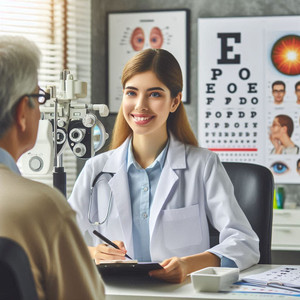What Are the Benefits of Comprehensive Eye Exams?
Annual comprehensive eye exams are essential not only for checking vision but also for identifying early signs of eye disease and other health conditions. A thorough exam typically involves two main phases: one focusing on vision and the other on the overall health of the eyes.
Phases of a Comprehensive Eye Exam
When a patient visits the ophthalmologist for the first time, the medical history is reviewed, followed by a series of tests:
-
Auto-refraction & Preliminary Prescription:
A pre-test is performed using an auto-refractor to estimate the patient's lens prescription. -
Keratometry:
This measures the curvature of the cornea and helps diagnose astigmatism. -
Tonometry (Eye Pressure Test):
A puff of air is applied to the eyes to measure intraocular pressure, used to detect signs of glaucoma.
If eye pressure is high, numbing drops are applied, and pressure is re-checked using an applanation tonometer, which uses a small lens resting gently on the cornea. This process is fast and painless.
Advanced Imaging for Eye Health
-
Optomap Digital Retinal Imaging:
This captures detailed images of the retina and detects problems not visible through traditional methods. -
Optical Coherence Tomography (OCT):
This imaging test scans the layers of the retina to detect conditions like glaucoma and macular degeneration in early stages.
Vision & Functional Tests
-
Visual Acuity Test:
Patients read letters on a board placed at a distance, with letter sizes decreasing to determine the sharpness of vision. -
Color Blindness Test:
Similar to the acuity test, this determines the patient’s ability to distinguish colors. -
Vision Mobility Test:
This checks eye muscle movement, pupil response to light, and peripheral vision. -
3D (Depth Perception) Test:
Measures how well both eyes work together to perceive depth.
Determining the Correct Prescription
A device called a phoropter is used to determine the proper prescription for glasses. The patient looks through different lenses, and the doctor adjusts the diopter settings while asking which lens appears clearer. This process helps finalize the corrective lens prescription.
Examination of the Internal Eye
The biomicroscope, also known as a slit lamp, is used to examine the back of the eye. A beam of light is passed into the eye to detect conditions such as:
-
Macular degeneration
-
Cataracts
-
Diabetic retinopathy
-
Corneal ulcers
Dilating drops may be used if the pupil is too small or overly sensitive to light, allowing for a better internal view.
Why Regular Eye Exams Matter
Comprehensive eye exams are vital for early detection of vision problems and the prevention of permanent vision loss. Regular check-ups, as recommended by your ophthalmologist, can help preserve your eyesight and overall eye health.
Disclaimer: The content in this email and blog post is intended for informational and motivational purposes only. It is not a substitute for professional medical advice, diagnosis, or treatment. Always consult qualified healthcare professionals before making changes to your routine, tools, or health practices. AccuSpire is not liable for any decisions made or actions taken based on this content.



 Aug 27th 2025
Aug 27th 2025